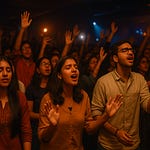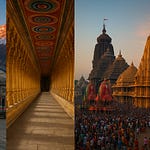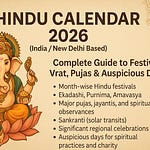Simhachalam: The Hill of the Lion God
Perched atop a lush, forested hill near Visakhapatnam (Vizag), Andhra Pradesh, the Sri Varaha Lakshmi Narasimha Temple in Simhachalam is more than just a temple—it's a gateway to transcendence. A spiritual fortress enveloped in divine aura, it is one of the 32 sacred Narasimha Kshetras and a powerful pilgrimage site dedicated to Lord Vishnu’s fourth avatar—Narasimha, in his Varaha-Narasimha form.
🕉️ Origins & Foundation: The Legend Behind Simhachalam
The temple’s origin traces back to the Satya Yuga, and is tied deeply with Hiranyakashipu, Prahlada, and the fierce Narasimha Avatar.
After slaying the demon Hiranyakashipu to protect his devotee Prahlada, Lord Narasimha’s wrath could not be calmed. The child devotee Prahlada prayed to Goddess Lakshmi to soothe Narasimha’s fury. His wish was granted, and Lord Vishnu took a unique form combining the boar (Varaha) and the man-lion (Narasimha)—Varaha Lakshmi Narasimha. This form symbolizes protection, preservation, and divine justice.
The term ‘Simhachalam’ literally means “The Lion’s Hill”, and it is believed that Prahlada himself consecrated the deity here. Ancient scriptures such as the Skanda Purana and Varaha Purana make references to this kshetra, calling it ‘the most sacred place on Earth’.
📖 Historical Background: Chronicles of Dynasties and Devotion
The present structure of the temple is believed to have been built in the 11th century, but archaeological records and inscriptions suggest a much older origin, going back to the 9th century CE.
Key historical associations:
Eastern Ganga Dynasty and later the Chalukyas and Cholas are believed to have patronized the temple.
Sri Krishna Devaraya of the Vijayanagara Empire visited Simhachalam and donated gold and jewels.
Over 252 inscriptions in Oriya, Telugu, and Sanskrit have been discovered here, chronicling donations, rituals, and temple activities over centuries.
The temple, with its Kalinga-Chalukya style architecture, was not just a religious center, but also a cultural and educational hub.
🛕 Architectural Grandeur: Stone, Sculpture & Symbolism
The temple's architecture is a glorious fusion of Kalinga and Chalukyan styles with hints of Dravidian influence.
Highlights include:
Mandapams (Halls) with intricately carved pillars and ceilings.
The outer wall (Prakara) is adorned with sculptures of gods, goddesses, celestial beings, and mythological scenes.
A five-tiered Gopuram towers above the main entrance, symbolizing the ascension to divinity.
The Garbhagriha (sanctum sanctorum) houses the main deity, kept covered in sandalwood paste throughout the year—a unique tradition.
Only once a year, during the Chandana Yatra (Akkanda Tadiya), the deity is revealed in his original form.
🔱 The Deity: Lord Sri Varaha Lakshmi Narasimha
The main deity is an eight-armed idol, showcasing the fierce but composed form of Varaha Narasimha.
He carries a chakra, conch, gada, lotus, sword, and a plough, symbolizing his protector and preserver aspects.
His expression is fierce—protective and wrathful—yet serene due to the calming grace of Goddess Lakshmi.
The deity is always covered with a thick layer of sandalwood paste, which cools the fierce energy of the god.
This ritual covering is said to make the deity appear like a Shivalinga, merging Shaivite and Vaishnavite traditions.
🪔 Rituals, Puja, and Aarti
The temple follows strict Vaikhanasa Agama traditions. Daily rituals include:
🕯 Daily Sevas:
Suprabhata Seva – early morning wake-up call with Vedic chants.
Nitya Archana – daily worship with flowers, incense, and mantras.
Harathi Seva – ceremonial lamp offering in the morning and evening.
🌺 Weekly & Monthly Pujas:
Ksheerabhishekam (Milk Abhishekam) – performed only on special occasions.
Panchamrita Abhishekam – with milk, honey, ghee, curd, and sugar.
🔔 Annual Festivals:
Chandana Yatra / Chandanotsavam (April-May) – when the sandalwood paste is removed and devotees get Nijaroopa Darshanam (true form darshan).
Narasimha Jayanti – celebrated with great fervor, marking the appearance of the Lord.
Vaikuntha Ekadashi, Brahmotsavam, and Karthika Deepotsavam attract lakhs of devotees.
🎵 Bhajans & Cultural Traditions
The temple has a vibrant bhajan and cultural tradition. Devotees often gather for:
Hari Nama Sankeerthana
Govinda Bhajans
Narasimha Slokas & Kirtanas
The temple’s nadhaswaram and mridangam artists carry forward centuries-old musical heritage, enhancing the temple's atmosphere with spiritual resonance.
🔮 Mysteries & Divine Phenomena
🕵️♂️ The Sandalwood Mystery:
For 364 days a year, the deity is coated in sandalwood paste. When it is removed, devotees are stunned by the radiating power of the deity's original form—fierce yet divinely magnetic.
🌿 Medicinal Herbs:
The sandalwood used is mixed with rare herbs, believed to have cooling and healing properties.
🌑 Lunar Timing:
The annual unveiling of the deity’s form is calculated using lunar calendars, precisely aligned with cosmic energies.
🧘 Spiritual Significance
Simhachalam is believed to remove inner fears, karmic blocks, and negative energies. Devotees believe:
A darshan of Narasimha here protects families from misfortune and evil.
Couples pray here for offspring and harmony.
Businessmen and farmers seek success and abundance.
It is considered one of the most powerful Kshetras for protection and justice, second only to Ahobilam in Narasimha lore.
🙇 Devotee Experiences: Faith Beyond Words
Devotees from Andhra Pradesh, Odisha, Tamil Nadu, and beyond speak of:
Miraculous recoveries from illness
Dream visitations from the deity
Unexplained protection during life-threatening situations
For many, it is not just a temple visit—it is a life-altering experience, filled with tears, surrender, and spiritual upliftment.
🧭 How to Visit: Travel Guide to Simhachalam
📌 Location:
Simhachalam Hill, 16 km from Visakhapatnam (Vizag) city center, Andhra Pradesh.
🚆 By Train:
Nearest railway station: Visakhapatnam Junction (VSKP)
🛫 By Air:
Nearest airport: Visakhapatnam International Airport, 18 km away
🚗 By Road:
Well connected by roads; auto-rickshaws and cabs available
RTC buses and shared jeeps ply regularly
🚡 Temple Transport:
Free electric buses (for seniors)
Trekking paths and Ropeway (proposed) for the adventurous
🏨 Nearby Stay:
Temple guesthouses and TTD choultries
Budget to 5-star hotels in Vizag city
🗓️ Best Time to Visit
October to March for pleasant weather.
April-May for Chandanotsavam, the most crowded and divine event.
Avoid monsoon (July-August) unless you're a fan of misty treks and spiritual solitude.
More Than a Temple
Simhachalam is not merely a destination; it’s a portal to the divine. From the echo of ancient chants to the majesty of its architecture, from the sandalwood mystery to the heartfelt prayers of the millions, the temple stands as an eternal symbol of divine justice, peace, and devotion.
In a world yearning for connection, Simhachalam remains a sanctuary where the soul feels seen, heard, and protected by the embrace of Sri Varaha Lakshmi Narasimha.
“Simhachalam is not where gods live, it’s where they reveal themselves.”










